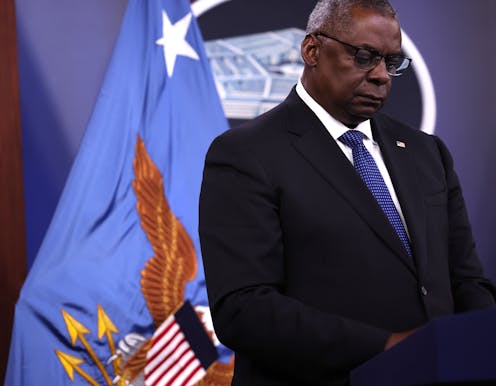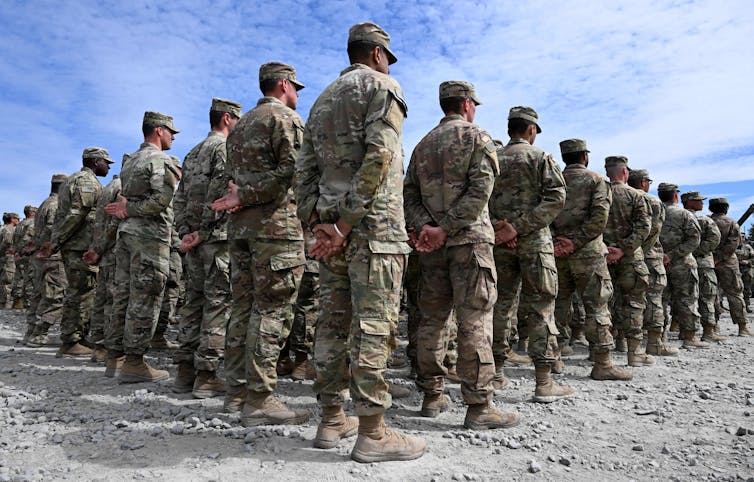Faced with a rise of extremism within its ranks, the US military has clamped down on racist speech,
For civilians, free speech is protected by the First Amendment. Not so in the US military, where the rise of political extremism has become a problem.

Less than a month after the Jan. 6, 2021, assault on the U.S. Capitol, Secretary of Defense Lloyd J. Austin took the extraordinary step of pausing all operations for 24 hours to “address extremism in the ranks.” Pentagon officials had been shaken by service members’ prominent role in the events of Jan. 6.
Of the 884 criminal defendants charged to date with taking part in the insurrection, more than 80 were veterans. That’s almost 10% of those charged.
More remarkable, at least five of the rioters were serving in the military at the time of the assault: an active-duty Marine officer and four reservists.
Service members’ involvement in the insurrection has made the spread of extremism – particularly white nationalism – a significant issue for the U.S. military.
Solving the problem
A blue ribbon committee called the Countering Extremist Activity Working Group was quickly commissioned in April 2021 to evaluate the extent of the problem.
The group found about 100 substantiated cases of extremism in the U.S. armed forces in 2021.
The latest instance occurred in July 2022, when Francis Harker, a National Guard member with white supremacist connections, was sentenced to four years in prison for planning an anti-government attack on police. Harker, who carried a picture saying “there is no God but Hitler,” was planning to attack police officers in Virginia Beach, Virginia, with Molotov cocktails and semi-automatic rifles.
Worried, Austin has tightened the rules regarding political speech within the military. The new rules prohibit any statement that advocates for “violence to achieve goals that are political … or idealogical in nature.” The ban applies to members of the military both on and off duty.
Also, for the first time, the new rules prohibit statements on social media that “promote or otherwise endorse extremist activities.”
While the intent behind the new rules is laudable, political speech – even of an offensive or distasteful nature – goes to the core of U.S. democracy. Americans in uniform are still Americans, protected by the First Amendment and afforded the constitutional right of free speech.
In light of the stricter policy, it is useful to consider how courts apply the First Amendment in the military context.
Good order and discipline
While soldiers and sailors are certainly not excluded from the protection of the First Amendment, it is fair to say they operate under a diluted version of it.
As one federal judge observed, the “sweep of the protection is less comprehensive in the military context, given the different character of the military community and mission.”
The “right to speak out as a free American” must be balanced against “providing an effective fighting force for the defense of our Country,” a federal judge noted in a separate case.
These and other federal judges point to the military’s need for good order and discipline in justifying this approach.
While never precisely defined, good order and discipline is generally considered being obedient to orders, having respect for one’s chain of command and showing allegiance to the Constitution. Speech that “prevents the orderly accomplishment of the mission” or “promotes disloyalty and dissatisfaction” within the ranks harms good order and discipline, and can be restricted.
In 1974, for example, the Supreme Court ruled that the Army can punish an officer for encouraging subordinates to refuse to deploy.
The officer’s comments included: “The United States is wrong in being involved in the Vietnam War. I would refuse to go back to Vietnam if ordered to do so.”
In 1980, the Seventh Circuit Court of Appeals ruled that the Army could legally fire an ROTC cadet for making racist remarks during a newspaper interview.
Explaining his political philosophy, the cadet said: “What I am saying is that Blacks are obviously further behind the whites on the evolutionary scale.”
In 2012, a San Diego district court ruled that the Marine Corps can lawfully discharge a sergeant who mocked president Barack Obama while appearing on the “Chris Matthews Show.” At one point the sergeant told the host: “As an active duty Marine, I say screw Obama and I will not follow his orders.”
While each of these statements is protected by the First Amendment in civilian life, they crossed the line in military life because they were deemed harmful to morale and represented what one federal court described as more than “political discussion … at an enlisted or officers’ club.”
The military’s job is to fight, not debate
In deciding these First Amendment cases, courts often hark back to why the military exists in the first place.
“It is the primary business of armies and navies … to fight the nation’s wars should the occasion arise,” the Supreme Court said in 1955.
In a separate case, the Supreme Court declared: “An army is not a deliberate body. It is the executive arm. Its law is that of obedience.”

Quickly following orders can mark the difference between life and death in combat.
On a national level, the degree to which an army is disciplined can win or lose wars. A mindset of obedience does not come solely from classroom training but from repeated rehearsals under realistic conditions.
As a military judge observed in a 1972 decision, while service members are free to discuss political issues when off duty, the “primary function of a military organization is to execute orders, not to debate the wisdom of decisions that the Constitution entrusts” to Congress, the judiciary and the commander in chief.
New policy bans ‘liking’ extremist messages
The U.S. military’s revised approach to political speech prohibits retweeting or even “liking” messages that promote anti-government or white nationalist and other extremist groups.
Does a restriction this broad comply with legal precedent?
As a law professor who has served more than 20 years in the U.S military, I believe the broader rules will probably be upheld if challenged on First Amendment grounds.
The most comparable case is Blameuser v. Andrews, a 1980 case from the Seventh Circuit Court of Appeals where an ROTC cadet espoused white supremacist political views in a newspaper interview.
Amongst other extremist remarks, the cadet told the reporter: “You see, I believe that in the final analysis, the Nazi Socialist Party will take over America and possibly the whole world.”
Finding that the statements harmed good order and discipline, the Seventh Circuit ruled that the Army did not violate the First Amendment when it subsequently removed him from the officer training program.
The cadet’s “views on race relations draw into question his ability to obey commands, especially in a situation in which he regards the military superior as socially inferior,” the Blameuser decision said.
The military has wide latitude in deciding who is deserving of the “special trust and confidence” that comes with military employment. Military officials are free to consider political and social beliefs that are “inimical to the vital mission of the agency” in making hiring and firing decisions, the Blameuser decision said.
Social media posts expressing support for violent political activities will likely be treated in the same way.
As the Seventh Circuit said in Blameuser, by liking or retweeting an extremist message, a service member’s actions are “demonstrably incompatible with the important public office” they hold.
Dr. Dwight Stirling is a reserve JAG officer in the California National Guard. The views expressed in this article are his own and do not necessarily reflect the official policy or position of any agency.
Read These Next
How to reduce gift-giving stress with your kids – a child psychologist’s tips for making magic and a
Depending on family circumstances and a child’s personality type, gift giving runs the gamut of fun…
Autocracies in transition: In 2025, Cameroon and Tanzania rulers clung to power — but look more vuln
The countries, whose respective leaders recently won widely disputed elections, offer contrasting examples…
Why are some Black conservatives drawn to Nick Fuentes?
Black Americans and white nationalists have joined forces in the past. And a number of cultural and…






